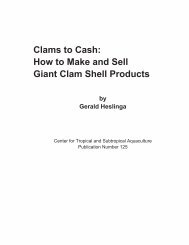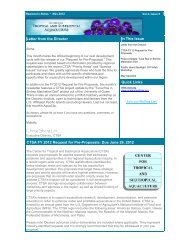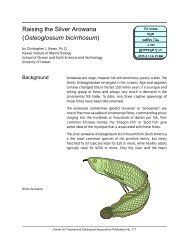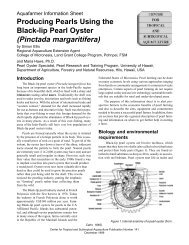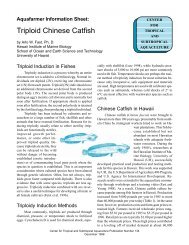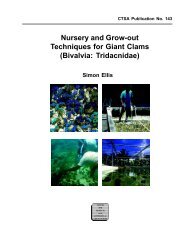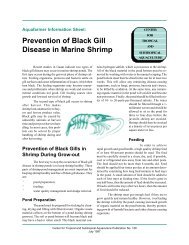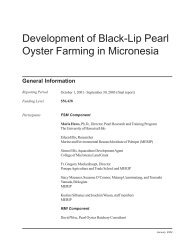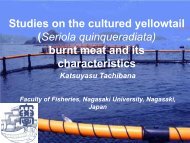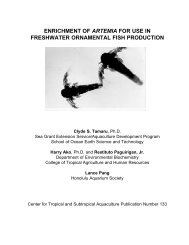The Basic Methods of Pearl Farming: A Layman's Manual - CTSA
The Basic Methods of Pearl Farming: A Layman's Manual - CTSA
The Basic Methods of Pearl Farming: A Layman's Manual - CTSA
You also want an ePaper? Increase the reach of your titles
YUMPU automatically turns print PDFs into web optimized ePapers that Google loves.
Nucleus implantation (grafting)<strong>Pearl</strong> oysters must be cleaned on a monthly basis before grafting; a final cleaning isdone just before grafting.Cleaning keeps the pearl oysters healthy and in good condition. <strong>The</strong> cleaning done just before graftingshould be a light and gentle cleaning so that the animals are not shocked.<strong>The</strong> technician may ask for you to perform pre-grafting conditioning.Technicians have different methods <strong>of</strong> conditioning the pearl oysters, but it is common for the technicianto ask the farmer to condition the pearl oysters about 6 weeks before grafting. Conditioning is ameans <strong>of</strong> inducing the pearl oysters to spawn, thus ridding the gonad <strong>of</strong> most <strong>of</strong> the egg or sperm, whichcan interfere with grafting. If grafting takes places just after the normal annual spawning, this may notbe necessary. Conditioning is done by raising the lines to the surface <strong>of</strong> the water for about 4 hoursduring the heat <strong>of</strong> the day. <strong>The</strong> increased temperature and reduction in water pressure makes the pearloysters spawn. After spawning, they are returned to their usual depth. It is important that this is notdone immediately before grafting since conditioning weakens the pearl oysters and they need time torecover.A special farm platform or building where the technician can work is needed.Grafting is usually conducted on a covered platform built over the water. This platform must be sturdilybuilt so that it does not shake while the technician is working. It should also be built in an area thatis deep enough to hang chaplets <strong>of</strong> pearl oysters. <strong>The</strong> water surrounding the platform must be calm andclear since sediment in the water can interfere with the quality <strong>of</strong> the seeding. <strong>The</strong> platform should alsobe spacious enough that workers can move around without disturbing the technician. Techniciansusually will request that a special table and chair be provided. Seeding can also be conducted on land,but this is not as convenient.<strong>The</strong> grafting procedureWhen the pearl oysters are brought to the platform for seeding, they are opened slightly with specialtools. A wooden peg is then inserted to keep the pearl oyster open until the seeding technician workson it. Care should be taken not to leave the pearl oysters open for longer than a few minutes as this cankill it.<strong>The</strong> seeding technician will look for a donor animal from which to take the mantle tissue graft. <strong>The</strong>mantle tissue <strong>of</strong> the donor animal determines the color and quality <strong>of</strong> the cultured pearl, so care shouldbe taken to use only pearl oysters with the most beautiful nacre for this. <strong>The</strong> donor is then killed and themantle tissue removed. This strip <strong>of</strong> mantle tissue is trimmed and cleaned until only a thin strip containingthe nacre-producing epithelial cells remains. <strong>The</strong> strip is then cut into tiny squares about 1/8 x1/8 in (2 x 3 mm) long. <strong>The</strong>se tiny pieces <strong>of</strong> mantle tissue will be inserted along with the nucleus intothe tissues <strong>of</strong> the pearl oyster. <strong>The</strong> transplanted mantle “graft” will grow, covering the nucleus with aPage 53



